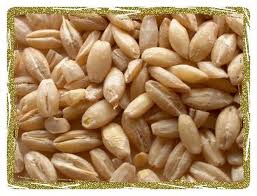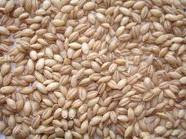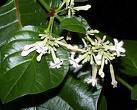 SWEET ALMONDS, PRUNUS DULCIS
SWEET ALMONDS, PRUNUS DULCIS
Sweet almonds and
bitter almonds are closely related to the
peach tree and it is believed that they may have had a common ancestor. They are in the
rose family and so are also more distantly related to the
plum,
cherry and
apricot. A gum exudes from the tree which can be substituted for Gum
Tragacanth. (gond katira). Like the peach tree
Prunus dulcis is native to the Middle East and Pakistan Syria, and Turkey.
By 3,000 BC the trees were domesticated in the Middle East, and we know from archaeological evidence that wild almonds were eaten 8,000 years ago. They were spread throughout the Mediterranean by Egyptians, Greeks and Romans, and it is thought that perhaps the Romans took them to Britain.
They have been used for centuries both as food and medicine. The ancient Romans thought they could stop a person becoming inebriated, and so, apparently did John Gerard, writing in the 16th century. He believed that eating 5 or 6 would prevent drunkenness.
Not surprisingly the figure in some preparations made by 12th century Arab physicians, for bronchial problems and coughs. Here is one for coughs and pharyngitis; -
Take six dirhams each of gum arabic, gum tragacanth, starch
, licorice juice, sugar, and confection, and five dirhams each of seed of decorticated
quince, pip of the sugared gourd, and decorticated
sweet almond. Bray them all, sieve, and add some concentrated and foaming julep. Boil until it forms a single whole. Remove and use" (Al-Samarqandi)
This remedy was for hoarseness:-

“fleawort, quince seed,
marshmallow seed, violet [seed],
purslane seed, [seed of] the two
cucumbers, [seeds of]
lettuce, poppy, mallow,
pumpkin,
almond,
sesame, and their oils..."
These ingredients were used because of their mucilaginous qualities.
Another prescription, for a child’s cough calls for liquorice, tragacanth, sweet almonds, gum Arabic, and sugar all kneaded in mucilage of quince, which was then made into pastilles. Ibn al-Tilmidh (ca 1165).
Gerard has this to say about them: -
'The oil newly pressed out of Sweet Almonds is a mitigator of pain and all manner of aches, therefore it is good in pleurisy and colic. The oil of Almonds makes smooth the hands and face of delicate persons, and cleanseth the skin from all spots and pimples.'
Almond oil from the kernels is still used in cosmetics and soap today, and used for dry skin in particular.

Writing later in the 17
th century, Culpeper has this to say, concurring with the Arab physicians that almonds are good for the liver and the brain when used in almond butter, and have a feel-good effect: -
'This kind of butter is made of Almonds with sugar and rose-water, which being eaten with
violets is very wholesome and commodious for students, for it rejoiceth the heart and comforteth the brain, and qualifieth the heat of the liver.”
In Greek mythology Phyllis was changed into an almond tree when her lover Demophon abandoned her. She was grief-stricken and she, or rather the almond tree she had become, seemed to have died. However, the lover returned and hugged the tree which burst into blossom, thus making it a symbol of love triumphing over death.
The almond was popularized in cooking by the Mughal emperors, but prior to that a woman with dark sultry almond-shaped eyes was the epitome of feminine beauty in the Indian sub-continent. In cards the heart suite is called badem or almond in many languages in the Indian subcontinent today.

Spenser in his 16
th century epic poem “The Faerie Queene” has this image of the almond tree:
Like to an almond tree ymounted hye
On top of greene Selinis all alone,
With blossoms brave bedecked daintily;
Whose tender locks do tremble every one,
At everie little breath, that under heaven is blowne.
- The Faerie Queene
(bk. I, canto VII, st. 32)
While Christopher Marlowe has these lines:
“Like to an Almond tree ymounted hye

Upon the lofty and celestial mount
Selinis queintly dect
With evergreen blossoms more white than Hericanas browes,
Whose tender blossoms tremble everie one
At everie little breath that thorow Heaven is blowen.”
It is not certain which poet did the plagiarizing.
Shakespeare in “Troilus and Cressida” makes an illusion to the saying prevalent in his day in Renaissance England, “an almond for a parrot” which was considered the height of temptation. His line is “The parrot will not do more for an almond.”
In traditional medicine, then the almond has been used to cure a number of ailments and apart from the ones mentioned above it was also used for gall and kidney stones in the form of almond milk mixed with gum Tragacanth or arabic. (You can make almond milk by pounding sweet almonds in water.) The oil has been used to promote hair growth, while the leaves were used to treat diabetes. Bruised leaves, rubbed onto the hands will remove the smell of
garlic,
onions etc. Almonds have been used to treat cancer, asthma, indigestion, water retention, peptic ulcers and have been used as a laxative (they are much more palatable than
senna and
jamalgota for example), and have been added to the oil of the
castor bean for the same purpose, to make the oil more pleasant to take.

The tree has other uses too, as in Tuscany, Italy the slender branches were used for divining rods, like wands from the
hazel tree, but not to find water or thieves, but hidden treasure.
The nuts contain the
minerals calcium, potassium, iron and phosphorous as well as some of the
B-complex vitamins, beta-carotene, fatty acids and ascorbic acid (
vitamin C). Hydrogen cyanide is present in both the leaves and nuts, so you should only consume them in small quantities. The nuts also contain amygdalin.

The tree contains taxifolia which is a substance believed to be an anti-tumour compound, although research is still being carried out on it.
Almonds are often found in bars of
chocolate, ice cream, biscuits, cakes and desserts, as well as in biryanis (savoury rice dishes). You can also crush sweet almonds and add them to
sattu for a refreshing, cooling summer drink. This is a folk remedy for gall and kidney stones.
To try a recipe using almonds, why not see our
biryani recipe?
 The whole plant is used in traditional medicine systems for a number of ailments. These include impotence and quality of sperm. The powdered seeds are given in milk to improve the male libido, so it is supposedly an aphrodisiac. It is used for liver problems, including jaundice, to treat urinary tract infections and for gout and oedema. It is said to have diuretic qualities.
The whole plant is used in traditional medicine systems for a number of ailments. These include impotence and quality of sperm. The powdered seeds are given in milk to improve the male libido, so it is supposedly an aphrodisiac. It is used for liver problems, including jaundice, to treat urinary tract infections and for gout and oedema. It is said to have diuretic qualities. In an earlier study reported in the same journal in 1995 reported by Singh A. and Handa S.S, concluded that it does act to protect the liver, but once again, the study was done on lab animals.
In an earlier study reported in the same journal in 1995 reported by Singh A. and Handa S.S, concluded that it does act to protect the liver, but once again, the study was done on lab animals.















































